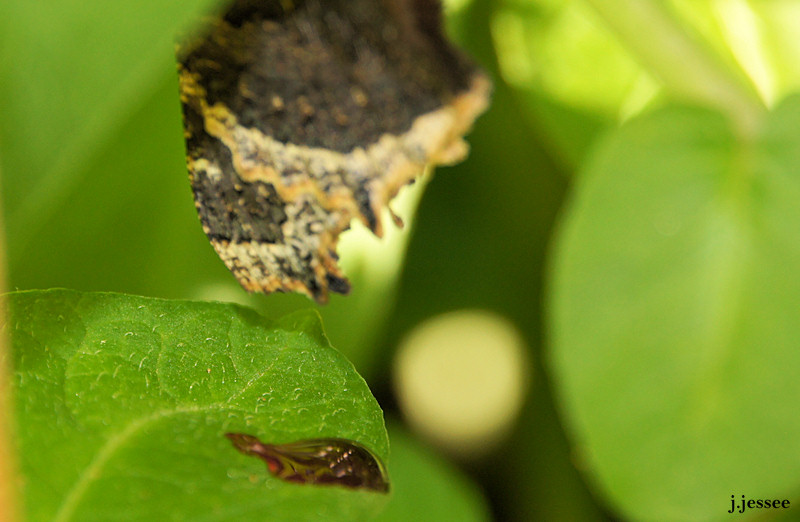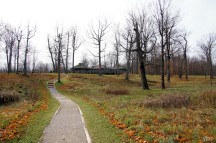Sweet Briar Lake, North Dakota
Yes, you can hear the trucks in the background from I-94 but that is the only negative thing about this wonderful place.
Driving across country last summer, my husband and I were always on the lookout for nice, clean, free campgrounds. We found a handful that we remember with fondness and this one tops the list.
Sweet Briar Lake was created by a dam if I remember correctly, and it appears to be a good fishing spot. But if you care about birds, this place is a bonanza. From just our little spot overlooking the lake we watched white pelicans, double-crested cormorants and Canada geese swim around and generally busy themselves, and heard red-winged blackbirds make their lovely background music. Most likely a walk around the lake would have resulted in seeing more species but we were more than thrilled to just stay put and enjoy this peaceful display.
Kolea, Akekeke & Honu
It’s interesting to see which bird species congregate together, or at least tolerate each other if their habitats overlap. In this case it’s the Pacific Golden-Plover and Ruddy Turnstone, or in Hawaiian terms Kolea and Akekeke, respectively.
These birds were foraging on the lava rock beach on the western coast of the Big Island of Hawaii. The turnstone is keeping itself busy in the shallow pool, bathing and looking for food, possibly turning stones over like its name implies it should. It draws the attention of two plovers who seem determined to intimidate the turnstone, or at the very least keep an eye on him or her. The plovers are only slightly larger than the turnstone, 1/4 inch in length, according to National Geographic Field Guides, but maybe that’s enough to be the generally more dominant species. There are photos of other sights in this area underneath the video, such as a green sea turtle (Honu, in Hawaiian), a wasp and what I think is a Wandering Tattler.
Randall Davey Audubon Center, Santa Fe
My husband and I were a little disappointed about only seeing a couple of birds at the Randall Davey Audubon Center in Santa Fe but we went during the hottest part of the day in early May so we weren’t too surprised.
There were numerous finches at the feeder, a gorgeous hawk moth at some flowers, a squirrel keeping busy digging in the dirt, and an unknown bird foraging in the bushes and parking lot.
What makes this place special are of course the volunteers and the beautiful terrain including the hillside trails, and the gorgeous adobe buildings. And the awesome bee hotel deserves a mention. I’d like to go back someday when it’s a little cooler, perhaps in the winter when there are more birds around.
Salida, Colorado: Sands Lake SWA
 The second part to the amazing May 2017 birding experience I had in Salida, Colorado was Sands Lake State Wildlife Area. It consists of Sands Lake and a stretch of the Arkansas River – my husband and I spent about an hour walking the lovely trails and walkway along the river.
The second part to the amazing May 2017 birding experience I had in Salida, Colorado was Sands Lake State Wildlife Area. It consists of Sands Lake and a stretch of the Arkansas River – my husband and I spent about an hour walking the lovely trails and walkway along the river.
The lake has had a lot of effort put into it to be bird friendly. Two islands naturally create a safe atmosphere for waterbirds like pelicans, geese and ducks. And at least two nesting platforms have been put up, as well as a handful of (floating?) platforms scattered around the lake.
The most exciting sighting of the day was an American Dipper, a first for me. And I even managed to get a decent shot of it.
We also saw a yellow-rumped warbler, several yellow warblers, cedar waxwings, and tree swallows in areas along the river and lake. A memorable sighting was the pair of ospreys, one on a nest and the other perched on a light pole nearby. Below are the rest of the photos. Hope you get to visit Salida some day!
Salida, Colorado: Frantz Lake & the Arkansas River
Last summer my husband and I were able to take a 3 month trip from Texas to Alaska. We spent most of our time in New Mexico and Colorado, in May, and both of those states provided some amazing birding.
Salida, Colorado was a birding bonanza: Frantz Lake along the Arkansas River and the nearby Sands Lake (in the next post).


 Frantz Lake is located on county road 154 near the Mt. Shavano Fish Hatchery. Google Maps has it listed as “Franz” – a different spelling; I took my spelling from the sign at the lake.
Frantz Lake is located on county road 154 near the Mt. Shavano Fish Hatchery. Google Maps has it listed as “Franz” – a different spelling; I took my spelling from the sign at the lake.
County road 154 is a birding spot in itself. Mountain bluebirds and tree swallows nest in the birdhouses that have been erected along the road. Canada geese and mule deer abound. *Click on the first image below and scroll to the right to view a larger image and see captions.*
Frantz Lake itself is a nice little turquoise-tinted reservoir next to the Arkansas River. Here I found 2 grebes, a western and a pied-billed, common mergansers, and white-faced ibises (a first!). Along with Canada geese, blackbirds and mallards.
A little ways away, by the Arkansas River, a red-tailed hawk flew overhead and white-crowned sparrows were foraging and flitting around on the dirt trail.
(Some of these images are sized 1920×1080 so can be used for that size monitor, I kept the copyright small. I like desktop wallpaper with a lot of blank space so it doesn’t feel cluttered and a couple of these photos work well for that.)
It snowed while we were in Salida in the middle of May – it’s at 7000 feet – but that was the day we were leaving and the sun came out just a bit later, so no harm done. 🙂 Thanks for looking!
Raven’s nest in moose antlers
A few years ago I went with my husband up the Dalton Highway to Prudhoe Bay. We stopped a few different places including a storage yard and former state camp called Happy Valley where I found one of the most wonderful things I’ve ever happened upon… a raven’s nest in a mounted rack of moose antlers with two babies in it!
Wild Turkeys in Hawaii
There are tons of wild turkeys on the Big Island of Hawaii! They roam the golf courses and lava rock fields searching for insects, lizards, seeds, berries and anything else that’s edible and relatively small. It’s a lovely thing to see.
The Wild Turkey evolved in America and was domesticated by Native Americans. In the early 1500s turkeys domesticated by the Aztecs were taken to Europe and interestingly enough, their descendants were brought back to America by the pilgrims who soon found out their indigenous neighbors were raising them too.
They spread to China and in 1788 they were introduced from there to the Hawaiian islands. Over the years, more have been released, whether purposely or not, by ranches and farms and perhaps by people who wanted to hunt them. Currently you can hunt them on the island along with pheasant, doves, francolin, quail, as well as introduced mammals such as goats, sheep and boar.
Turkeys especially prosper on the Big Island because of it’s dry grassy sloping landscapes, and as you can see, they seem right at home.
Raven yanks another raven’s tail
The average adult raven is about 2.5 pounds and it’s hard to tell adults from juveniles. The below video shows a power struggle between ravens at a food source. At the very beginning you can see a raven on the far left grab another raven’s tail feathers with his beak and pull him or her away from the food. Another seems to join in. (By the way, if the video is blurry find the settings in the bottom right hand corner of the player and change it to a higher resolution. Youtube automatically chooses a low setting so it will download faster.)
After reading Ravens in Winter, a book by Bernd Heinrich, I’m inclined to believe that the commotion going on in the video has to do with a power struggle (to gain access to the food) between the juvenile birds and the adults. According to Heinrich, adults are usually silent at carcasses (dead animals in the wild), and juveniles are very noisy. The juveniles “yell” at kills and make a commotion, possibly to attract more juveniles to the kill, in order to compete with the adults and gain access to the food.
Heinrich “proves” through observation and careful note-taking that ravens actively recruit other ravens to food piles. He speculates, after studying raven behavior for many years, that this recruitment is not necessarily altruistic, or done in order to get the favor back some day. Instead, it is probably related more to “gaining or maintaining access to the food than to sharing the wealth.”
Juveniles actively recruit, in order to overwhelm by sheer numbers, the adults at the carcass, so that the adults will give up defending the carcass, which they do when they are just too outnumbered.
So if we can extend this power struggle at carcasses in the field to city food (trash) then it’s possible the squawking raven in the video, the one being pulled from the food by his or her tail feathers, is likely a juvenile, being bossed around by the adults, who are not as vocal.
I strongly encourage any bird lover to read Ravens in Winter. This bird that I see nearly every day of my life is actually quite mysterious and Heinrich helps us understand their possible and likely motivations.
Thanks for reading! Happy New Year!
Black-Capped Chickadee Beak Deformity
 I made this little animation to show how this poor chickadee was being bothered by its beak deformity. Every so often it would rub its beak against the edge of the bird feeder like this. It appeared relatively healthy so it must have been able to eat satisfactorily, but apparently this deformity causes it to be obsessive about trying to scrape off the excess beak.
I made this little animation to show how this poor chickadee was being bothered by its beak deformity. Every so often it would rub its beak against the edge of the bird feeder like this. It appeared relatively healthy so it must have been able to eat satisfactorily, but apparently this deformity causes it to be obsessive about trying to scrape off the excess beak.
Spruce Grouse, not hunted
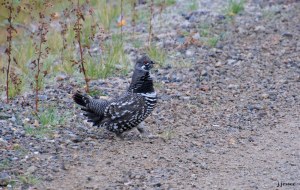 The spruce grouse is a very common bird in interior Alaska. It’s one of several species of grouse that live in this state.
The spruce grouse is a very common bird in interior Alaska. It’s one of several species of grouse that live in this state.
The one on the left has red combs above its eyes so we know it’s a male (click it for a better view). I’ve seen quite a few spruce grouse over the years but never have I seen the courtship display. The National Geographic Feild Guide to Birds says “In courtship strutting display, male spreads his tail, erects the red combs above his eyes, and rapidly beats his wings; some males also give a series of low-pitched hoots.” This would be something to see!
The male on the left is standing next to the Trans-Alaska Pipeline and my husband and I saw at least 10 or 20 when we were driving the pipeline access road for a couple of hours. The spruce grouse is a game bird and hunters can take them throughout Alaska except during the months of May, June & July (with a few exceptions). It is somewhat common to hunt them for food. To me, this is a necessary evil. I’m a birder and I consider myself an environmentalist but I think that hunting has a role to play in a healthy diet. As long as the bird dies quickly and the meat is used for food I am not against this. I have had ptarmigan myself, but never grouse. It was delicious. Eating a bird that has had a ‘happy’ life is better for everyone, and for the world, than one who lives in tiny cages or in huge flocks in warehouses.
Residents of Alaska can also kill cormorants, crows, and Snowy Owls, as long as they are taken for food or clothing. It sounds cruel but there are Alaska Native traditions that involve these birds and their feathers and this must be respected as long as the birds are not endangered.
 The spruce grouse on the right, and its chick, were spotted on a trail about a mile off the Steese Highway north of Fairbanks, back in 2006. You can see the female has a
The spruce grouse on the right, and its chick, were spotted on a trail about a mile off the Steese Highway north of Fairbanks, back in 2006. You can see the female has a  reddish-brown stripe over its eye, reminiscent of the male. I don’t remember exactly what time of year I took the photos but it was probably early June or late May. (I’m not sure exactly what to call the baby since it seems bigger than a chick and smaller than a juvenile. It’s more like a ‘tween. 🙂
reddish-brown stripe over its eye, reminiscent of the male. I don’t remember exactly what time of year I took the photos but it was probably early June or late May. (I’m not sure exactly what to call the baby since it seems bigger than a chick and smaller than a juvenile. It’s more like a ‘tween. 🙂
Hard to believe but this bird subsists mainly on spruce needles! They must have powerful digestive systems. They can stuff their crops full of the equivalent of 10% of their body weight, to be digested later, and their gizzards grow by 75% during the winter when their energy needs increase.
As someone who lives in interior Alaska year-round, I’m quite impressed with a bird that can live here in the winter. Along with ravens and chickadees, they have adapted some clever ways to make it.
Here’s to a mild winter for us all!
Bird Congregation
I don’t think this is a very common sight on the coastal plains of northern Alaska (or anywhere?), but as my husband drove in to Prudhoe Bay last spring, he spied this unusually large gathering of various birds.
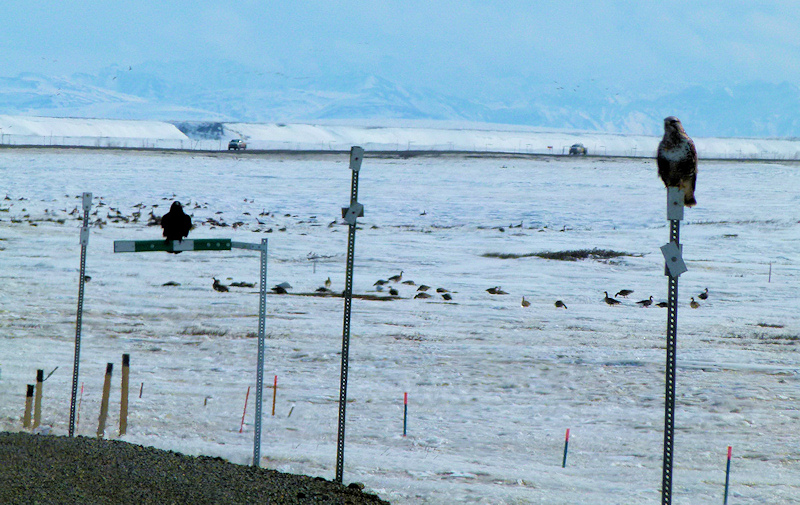 The rough-legged hawk and raven seem to be acting as sentries over the vast flocks, but they are watching for sinister purposes.
The rough-legged hawk and raven seem to be acting as sentries over the vast flocks, but they are watching for sinister purposes.
 Sure enough, a hawk has gotten herself a meal.
Sure enough, a hawk has gotten herself a meal.
 But really, how can you blame her?
But really, how can you blame her?
 A short-eared owl perches nearby.
A short-eared owl perches nearby.
Kind of hard to believe that little twig can hold him up. He must be all fluff.
And life goes on….
Redpoll Baby (and it just stopped snowing!)
I’m happy to say my husband caught the birding bug! He took this photo of a juvenile redpoll. I would even go as far as calling it a baby redpoll. It’s hard to tell how tiny it is, but he said just a couple inches, really small. The short tail feathers probably enhance the tiny effect.
We’re a bit surprised that there are fledged redpolls this early in the spring. It stopped snowing less than 2 weeks ago! And now it’s 70 degrees, go figure. Either way, my husband said this little guy flew away,barely, so maybe he or she will have a fighting chance.
“Planned Pigeonhood” in Waikiki
 If you’ve been fortunate enough to visit the beautiful island of Hawaii you’ve probably visited Honolulu. And if you’ve visited Honolulu that means you’ve probably been to Waikiki. And if you’ve been to Waikiki that means you’ve seen the pigeons (a.k.a. rock doves).
If you’ve been fortunate enough to visit the beautiful island of Hawaii you’ve probably visited Honolulu. And if you’ve visited Honolulu that means you’ve probably been to Waikiki. And if you’ve been to Waikiki that means you’ve seen the pigeons (a.k.a. rock doves).
Lovely birds, as special as any living creature, but not very popular with the tourists.
Hawaii is a common destination for Alaskans in the winter. With an almost total lack of sunshine from November to February we pledge to ourselves that this winter we are getting out! Hopefully it happens. And there is nary a more direct route to full-on sunshine then the quick five or so hours from Anchorage to Honolulu.
 The pigeon on the very left is looking pretty mangy (click on the photo to see it larger). There are so many pigeons in Waikiki, with no natural predators anywhere in sight, that they over breed and become a danger to themselves and people. The photo on the right shows another pigeon from Waikiki, this one missing a foot and walking around a restaurant hunting for food scraps and somehow managing to avoid being clobbered.
The pigeon on the very left is looking pretty mangy (click on the photo to see it larger). There are so many pigeons in Waikiki, with no natural predators anywhere in sight, that they over breed and become a danger to themselves and people. The photo on the right shows another pigeon from Waikiki, this one missing a foot and walking around a restaurant hunting for food scraps and somehow managing to avoid being clobbered.
So when I saw this posting by the Human Society about OvoControl, a contraceptive-laced food that property owners can feed pigeons, I was thrilled. It describes how the manager of The International Marketplace, one of the most popular tourist destinations in Waikiki, chose to take a chance on the product and saw a 60% reduction in pigeons after 12 months. (It costs $9 a day to feed/treat 100 pigeons.)
Talk about an ideal non-violent and humane solution! Maybe this will catch on in communities that are fed up with the overpopulation of this city-loving bird.
A Snow Bunting at Pictured Rocks
I saw a snow bunting once before, in Prudhoe Bay, Alaska. In its summer garb. But this one I spied on a gravel road in Pictured Rocks National Lakeshore in Michigan in its winter plumage. My husband and I were in the middle of a 6 week long road trip that started and ended at our home in Fairbanks, Alaska, but that took us through 4 Canadian provinces and at least 14 states. And of all the amazing times we had this snow bunting was actually pretty special because it was one of the few close encounters with birds that I had over the whole 6 weeks.
 Michigan’s scenery, little did I know, is astoundingly beautiful! I had no idea there were sand dunes in the Midwest! Sleeping Bear Dunes National Lakeshore (on left) is a must-see part of North America.
Michigan’s scenery, little did I know, is astoundingly beautiful! I had no idea there were sand dunes in the Midwest! Sleeping Bear Dunes National Lakeshore (on left) is a must-see part of North America.
As is Pictured Rocks National Lakeshore on the Upper Peninsula of Michigan. You can see red-orange sandstone that is 500 million years old in the photo on the right. This cliff has been beautifully sculpted by the waters of Lake Superior. The interesting part is that even though the rock that makes up the landform is hundreds of millions of years old, the cliff itself that you see jutting out into the water is only a few thousands of years old. No landform around this area could be older than 12,000 years old because that’s when glaciers retreated at the end of the last ice age. But this land is rising. It has risen far enough up since then, and been sculpted by the forces of erosion, to give us a spectacular view of rock formations that used to be buried.
Upper Peninsula of Michigan. You can see red-orange sandstone that is 500 million years old in the photo on the right. This cliff has been beautifully sculpted by the waters of Lake Superior. The interesting part is that even though the rock that makes up the landform is hundreds of millions of years old, the cliff itself that you see jutting out into the water is only a few thousands of years old. No landform around this area could be older than 12,000 years old because that’s when glaciers retreated at the end of the last ice age. But this land is rising. It has risen far enough up since then, and been sculpted by the forces of erosion, to give us a spectacular view of rock formations that used to be buried.
So as my husband and I are visiting this most scenic of places, this snow bunting is pick pick picking at bits of something along a gravel road, letting me get closer and closer with my camera.
He must have just arrived from more northerly climes, smartly getting busy eating as many seeds and insects that he can before the coming winter. Snow buntings spend the summer in Alaska and northern Canada and before winter fly to the Midwest of America, southern Canada, and the coastlines of Alaska. Males have darker heads in the winter and more black on their wings, like this little guy.
I know all this about snow buntings now because I have my handy birding books around me. But when I was taking the photos I thought maybe it was a sparrow of some kind. To my delight, when I finally got home and looked it up I found out it was a snow bunting which is not a sparrow. I would have never recognized it because the one I saw in Prudhoe Bay was in it’s June breeding plumage which is mostly white. Moral of the story: take at least one birding book with you on your road trip!
Chipmunks at Athabasca Falls (not a bird to be seen)
My husband and I are presently traveling from the north of the United States – Alaska – to the south of it – North Carolina. I have gotten some unbelievable photographs of wildlife, including a close encounter with a grizzly bear that was digging up roots alongside the Alaska Highway (you can see them here).
 Jasper and Banff National Parks in Alberta, Canada were spectacular. Surrounded by sunlit mountains, we drove
Jasper and Banff National Parks in Alberta, Canada were spectacular. Surrounded by sunlit mountains, we drove  through the parks with our mouths agape, peaks above us and streams meandering through valleys below us. And though we saw barely a creature but tourist’s dogs in the parks, I did catch a few up close photos of scurrying chipmunks at Athabasca Falls in Jasper.
through the parks with our mouths agape, peaks above us and streams meandering through valleys below us. And though we saw barely a creature but tourist’s dogs in the parks, I did catch a few up close photos of scurrying chipmunks at Athabasca Falls in Jasper.
Canadians definitely have their national parks figured out, if these two are representations of them as a whole. Athabasca Falls had wooden stairways interspersed between towering rocks – sometimes you have to duck to or go single-file to get through. Lots of concrete walkways
Athabasca Falls had wooden stairways interspersed between towering rocks – sometimes you have to duck to or go single-file to get through. Lots of concrete walkways in different viewpoints of the falls, accessed by sun dappled paths with views of game trails through the moss. A peaceful and necessary stop, and in our case at least, not too crowded.
in different viewpoints of the falls, accessed by sun dappled paths with views of game trails through the moss. A peaceful and necessary stop, and in our case at least, not too crowded.
 The only large wild mammal we saw in the parks was Bighorn Sheep. A group of 6 or 7 were nibbling something on the rocks (my husband says they were ingesting minerals from the rocks). The chipmunks were also nibbling, moving with rocket speed over the concrete and moss, not too scared of us big hulking humans except perhaps to be caught underfoot.
The only large wild mammal we saw in the parks was Bighorn Sheep. A group of 6 or 7 were nibbling something on the rocks (my husband says they were ingesting minerals from the rocks). The chipmunks were also nibbling, moving with rocket speed over the concrete and moss, not too scared of us big hulking humans except perhaps to be caught underfoot.
So, no birds this time. The only ones I’ve managed to capture with my camera are swans and ravens, back up in the Yukon Territory. But that’s a post for another day. Until then, best wishes to you all…
Reflections on the Sandhill Crane
 The Sandhill Crane has a lot of personality. From their rattling call to their long legs and red banded eyes, you can’t mistake one. Especially given it’s statuesque 4 foot height… good thing they don’t want to get too close to us because they would probably be quite intimidating!
The Sandhill Crane has a lot of personality. From their rattling call to their long legs and red banded eyes, you can’t mistake one. Especially given it’s statuesque 4 foot height… good thing they don’t want to get too close to us because they would probably be quite intimidating!
 The one on the left popped up at a pond my husband and I like to visit near our house. In May, full of mosquitoes, but an unexpected sweet birding spot. This bird wanted us to remove ourselves quickly. I presume it was spreading its wings in an attempt to make itself look bigger and more menacing. It was having a private moment, who are we to interrupt!? So we snapped a couple shots and skedaddled. (Although I don’t know that this would be a safe place to make a nest because of neighborhood dogs or other wandering animals like foxes.)
The one on the left popped up at a pond my husband and I like to visit near our house. In May, full of mosquitoes, but an unexpected sweet birding spot. This bird wanted us to remove ourselves quickly. I presume it was spreading its wings in an attempt to make itself look bigger and more menacing. It was having a private moment, who are we to interrupt!? So we snapped a couple shots and skedaddled. (Although I don’t know that this would be a safe place to make a nest because of neighborhood dogs or other wandering animals like foxes.)
 As you can see, they have a lot of color variation, in fact their rust and gray blend is quite striking, having an almost metallic glint to it.
As you can see, they have a lot of color variation, in fact their rust and gray blend is quite striking, having an almost metallic glint to it.
The photos on the right are from Creamer’s Field, an awesome place in Fairbanks to see migrating cranes, geese, and ducks. (I’ll do a 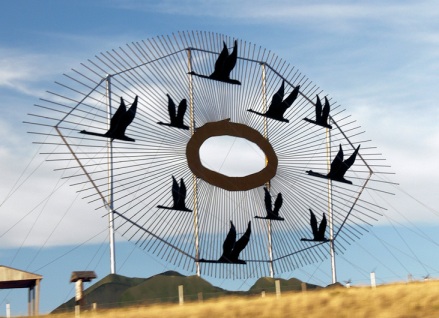 post on it in the future.) The pair on the right must be a parent and offspring, since the one hasn’t attained adult coloring of gray and red face. If you want to see a short video of this pair click here, but if you do, keep an eye peeled for the Canada Geese in the background waddling through the grass.
post on it in the future.) The pair on the right must be a parent and offspring, since the one hasn’t attained adult coloring of gray and red face. If you want to see a short video of this pair click here, but if you do, keep an eye peeled for the Canada Geese in the background waddling through the grass.
The splendid artwork on the left was found driving through North Dakota or thereabouts, and if I remember right they were celebrating a crane festival. Apparently, I’m not the only one who finds Sandhill Cranes to be extraordinary creatures! —————————
Remember, you can click on any of these images to see their maximum size, and then click the “back” button to get back to this page. And, if you need the font size to be bigger on this or any webpage, press Ctrl at the same time as the + sign.












































































